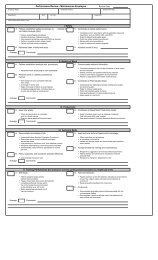Building Operating Management September 2011 - FacilitiesNet
Building Operating Management September 2011 - FacilitiesNet
Building Operating Management September 2011 - FacilitiesNet
Create successful ePaper yourself
Turn your PDF publications into a flip-book with our unique Google optimized e-Paper software.
78<br />
buildingoperatingmanagement<br />
SEPTEMBER <strong>2011</strong><br />
What occupant characteristics can affect the way a<br />
given building population will respond in a fire? Beyond<br />
the ones just mentioned, important characteristics can include:<br />
age; gender; level of alertness; physical and cognitive<br />
ability; building population and density; and the activity<br />
performed by occupants at the time of the emergency.<br />
Understanding all of these human characteristics<br />
can be very helpful when developing and implementing<br />
a facility’s emergency plan. Although occupant characteristics<br />
cannot be changed, effective emergency planning<br />
will increase the likelihood that building occupants<br />
will evacuate to a safe location when there is a building<br />
emergency. Accordingly, when planning for an emergency,<br />
every plan should focus on nullifying specific human<br />
characteristics that may hinder an effective building<br />
evacuation. For example, if a facility has occupants who<br />
aren’t regular visitors to the building, the emergency plan<br />
should include the important role that staff has in assisting<br />
occupants who are not familiar with the building.<br />
Once this emergency plan is implemented, it is important<br />
that periodic drills be performed so that staff can<br />
become familiar with the plan.<br />
qDo Not Assume That People<br />
WIll Evacuate Just Because a<br />
Fire Alarm Sounds<br />
2.<br />
Typically, when a fire alarm system is activated in a public<br />
building, the response to the alarm is slow, if the alarm<br />
is not ignored entirely. Why? Sometimes occupants fail to<br />
recognize the signal or are unaware of the proper response;<br />
sometimes they just don’t hear the signal. Nuisance alarms<br />
also decrease system credibility.<br />
One of the foremost roles of a building’s fire alarm system<br />
is to initiate evacuation and ensure that sufficient time<br />
is available for the occupants to get out of a building before<br />
conditions become untenable. There are several steps that<br />
can be taken to increase the likelihood that occupants will<br />
respond immediately to a fire alarm signal.<br />
First, when selecting a fire alarm/emergency communication<br />
system for a building, consider a system that notifies<br />
occupants through voice communications. To ensure<br />
a successful evacuation in an emergency, people need information.<br />
They want to know what the problem is, what<br />
When selecting a fire alarm/emergency communication system, consider<br />
one that notifies occupants through voice communications<br />
Download the Facility Manager’s Toolbar for<br />
Internet Explorer and Firefox. Why?<br />
• Facilities-management-targeted search<br />
• Quick access to FM articles and topics<br />
• Ask questions and network with other<br />
facility professionals on my<strong>FacilitiesNet</strong><br />
It’s free. It’s extremely handy. Easy Install. Go for it.<br />
Download it today at www.facilitiesnet.com/toolbar<br />
Sponsored by<br />
Thank you UGL Services!<br />
▲ FREE INFO: Circle 463





